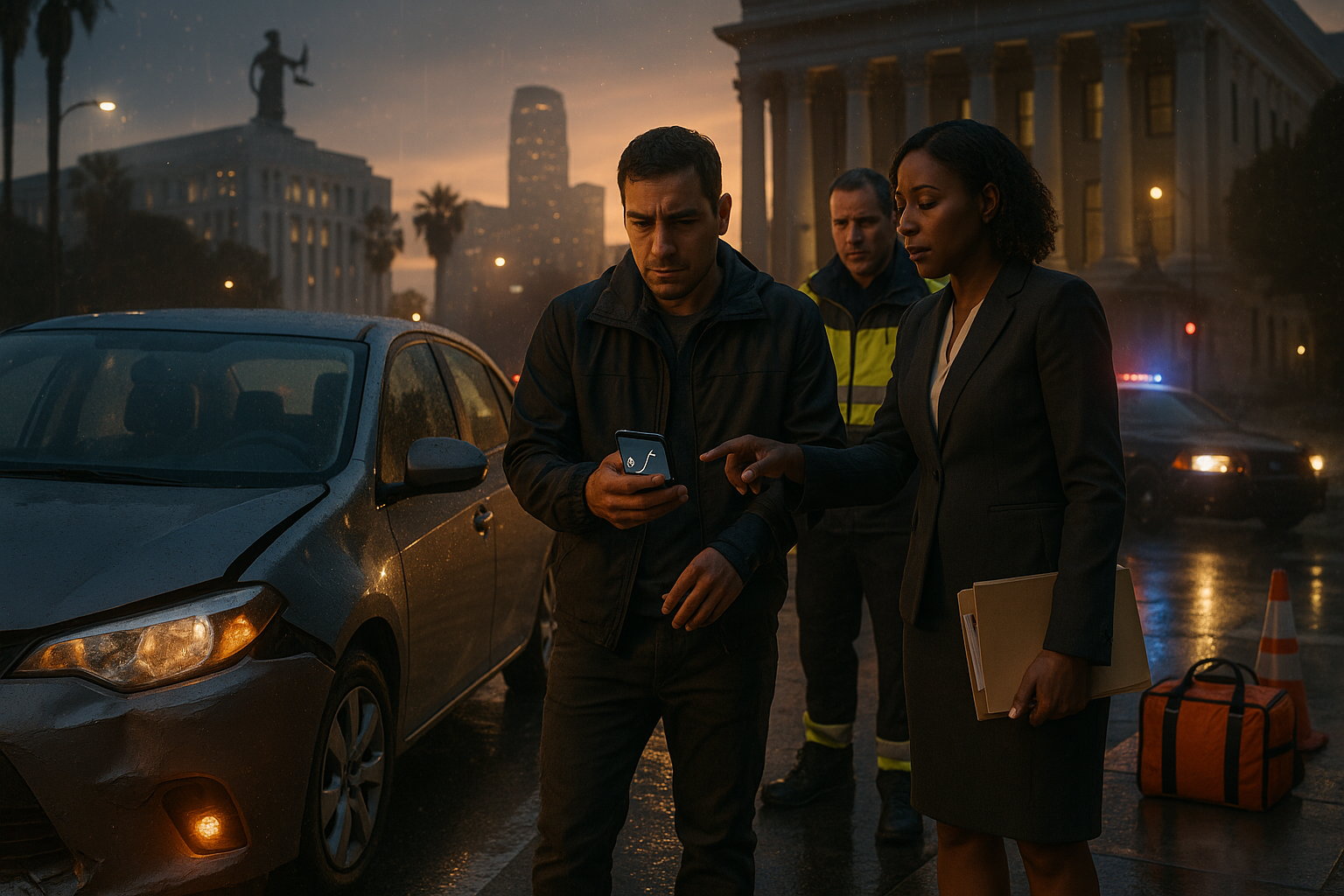Table of Contents

Estimated reading time: 12 minutes
Key Takeaways
- In California, most app-based drivers are treated as independent contractors under Prop 22, so traditional DWC workers’ comp does not apply unless the driver is proven to be an employee.
- Prop 22 provides a limited injury protection package only while a driver is “engaged” in a ride or delivery; benefits and coverage windows are narrower than traditional workers’ comp.
- If you can show you were misclassified under the ABC test (AB5), you may qualify for full workers’ comp benefits through the California Division of Workers’ Compensation (DWC).
- Documenting your app status, route, and trip details at the time of injury is critical to establish “engaged” coverage and to support any misclassification or DWC claim.
- Appeals and third-party claims may be available if Prop 22 benefits are denied or if another motorist caused the crash.
Quick summary / TL;DR
- Short answer: “Generally, gig workers in California are covered only by Prop 22’s limited benefit package rather than traditional California workers’ compensation; full DWC benefits apply only if you are an employee or successfully challenge misclassification.” — see Prop 22’s limited benefits overview and the California Supreme Court decision upholding Prop 22.
- Exceptions: “if you can prove you were misclassified as an independent contractor (employee status under the ABC test / AB5), you may be eligible for traditional workers’ comp.” — see the state’s AB5/ABC test guidance and a discussion of misclassification challenges in California’s gig economy.
Introduction
If you’re a gig driver or delivery courier in California, understanding your rights to gig worker injury compensation is critical if you’re injured on the job. This guide explains the law’s evolution from Dynamex and AB5 to Prop 22, what the Prop 22 workers comp California model does—and does not—cover, practical steps for Uber and DoorDash incidents, and where to get trusted help. For current legal context, see analysis of the California Supreme Court ruling upholding Prop 22 and an overview of Prop 22’s benefits and limits. We also clarify app-based worker injury rights so you can act fast and protect your claim.
What is workers’ compensation in California?
Workers’ compensation is California’s state-mandated insurance system that pays for medical care, temporary and permanent disability benefits, and death benefits to employees who are injured or become ill because of their job (system overview). The California Division of Workers’ Compensation (DWC) administers claims and appeals.
Only employees—typically not independent contractors—are eligible for DWC benefits, so how you are classified controls coverage. California uses the ABC test (codified by AB5) for most worker-classification questions (AB5/ABC test FAQ).
Timelines matter: injured employees generally must give notice quickly and meet claim deadlines. To learn how California’s timing rules and the “90-Day Rule” can affect eligibility, see the 90‑Day Rule explainer and this guide to filing deadlines.
The gig economy in California: Dynamex → AB5 → Prop 22 (context)
California’s gig-economy coverage has shifted over the last decade. In Dynamex (2018), the California Supreme Court adopted the “ABC test” for classifying workers. A hiring entity must show all three to treat a worker as a contractor: (A) the worker is free from the company’s control in performing work; (B) the worker performs work outside the usual course of the company’s business; and (C) the worker is customarily engaged in an independently established trade or business of the same nature as the work performed (ABC test explained).
In 2019, AB5 codified the ABC test and extended employee classification rules to many industries (AB5 codification).
In 2020, voters passed Prop 22, which carved out app-based transportation and delivery platforms, allowing them to classify drivers as independent contractors while mandating a limited benefit package in lieu of traditional workers’ comp (Prop 22 carve‑out and benefits). In 2024, the California Supreme Court upheld Prop 22, solidifying this framework (decision summary).
Practical effect: for many rideshare and delivery drivers, contractor status is the default, limiting access to the DWC system unless misclassification is proven. This matters for gig worker injury compensation because your classification determines whether you receive Prop 22’s limited protection or full DWC benefits.
Prop 22 explained: benefits, limits, and “Prop 22 workers comp California”
Prop 22 allows companies to classify drivers as independent contractors but requires a limited set of benefits for injuries sustained while “engaged in app-based activity” (Prop 22 overview; benefits summary).
- Prop 22 (limited benefits): partial medical expense coverage, limited temporary disability-style payments based on app-defined formulas, healthcare stipend thresholds, and capped death benefits (Laguna Law summary; Spencer Young analysis).
- Traditional DWC workers’ comp (if employee): comprehensive medical care through designated networks, temporary total disability (TTD) and permanent disability ratings, and formal oversight with appeals to the WCAB (Visionary Law Group guide).
What counts as “engaged”? Coverage typically applies only when a driver is actively performing a job: en route to a pickup, carrying a passenger, or on an active delivery—not merely logged in and waiting (eligibility window explained).
Legal environment: Courts have upheld Prop 22, but additional litigation and policy proposals remain possible. Monitor updates as they may affect benefit scope and enforcement (recent litigation update).
Who qualifies for gig worker injury compensation in California?
For app-based workers, there are two primary paths to benefits:
- Employee path: If you meet the ABC test, you are an employee and can access full DWC benefits. Under the ABC framework, the hiring entity bears the burden of proving all three prongs—control, business integration, and independent trade—to treat a worker as a contractor (ABC test details; misclassification challenges).
- Contractor path: If you remain a contractor under Prop 22, you receive only the limited package while “engaged,” not the full DWC system (Prop 22 benefits overview).
Indicators favoring employee status: company control over schedules/routes or discipline for low acceptance; performing the platform’s core business (transporting people or goods); and absence of a bona fide independent business (no advertising, no distinct client base). Indicators favoring contractor status: freedom to set hours, multi-apping across platforms, self-supplied vehicle/tools, and independent marketing.
How to challenge classification: You can claim employee status administratively by filing with the DWC and presenting evidence of control and integration. Alternatively, you may pursue civil misclassification litigation, sometimes as a class action (litigation context; compliance commentary for gig workers).
Do Uber drivers get workers comp?
Short answer: No—Uber drivers typically do not get traditional DWC workers’ comp unless reclassified as employees; instead they have Prop 22’s limited protections while “engaged” (benefit limits; Prop 22 upheld).
Coverage scenarios:
- Logged in but waiting: Many waiting periods are not covered, or receive reduced protection, because the driver is not “engaged” (waiting-time caveats).
- On trip/en route with a passenger: Generally covered under Prop 22’s limited benefits (medical and a formula-based disability payment).
- Driving to pick up vs. returning from trip: “En route” to a pickup usually counts as engaged; post-trip driving without an active assignment often does not. Documenting trip IDs and timestamps is crucial to prove status.
If injured: take screenshots of your app status (trip ID, time, GPS), photograph the scene and vehicles, seek medical care, and obtain a police report where appropriate. Report through Uber’s in-app safety center and follow the designated claims administrator’s instructions under Prop 22. If coverage is denied or status disputed, consider a misclassification claim or a DWC filing.
DoorDash injury claim California (step-by-step)
DoorDash couriers fall under Prop 22’s carve-out and may access limited injury benefits when actively “engaged” in a delivery (Prop 22 benefits for delivery; engagement status).
- Immediate medical care: go to emergency or urgent care as needed; keep all medical records and receipts.
- Preserve evidence: photograph injuries, vehicles, and road conditions; screenshot the order in-app (timestamps, status); save GPS routes.
- Report to DoorDash: use in-app Help/Safety or Incident tools right away; note the claim/report ID.
- File with the designated insurer: watch for email or portal instructions from DoorDash or its claims administrator; save every message.
- Track deadlines: meet carrier timelines; if you plan to challenge classification and pursue DWC benefits, mind the 30-day notice and related filing requirements (DWC benefits and DWC 1 form).
- If denied: collect proof showing company control and job integration and consult a workers’ comp attorney about a DWC claim or misclassification suit (misclassification context).
For a deeper dive on employee-route claims, see this guide to filing a California workers’ comp claim.
Injured while driving for delivery app — immediate actions (checklist)
- Safety and medical: get emergency care as needed; request copies of medical reports and bills (workers’ comp basics).
- Police/reporting: if other parties are involved, call law enforcement and obtain the report or case number.
- Preserve digital evidence: photograph vehicles, injuries, and road conditions; screenshot trip/delivery status, timestamps, route, and order/trip ID.
- Witness details: collect names, phone numbers, and brief statements.
- Report in-app: use the platform’s incident or safety reporting; save the confirmation/claim number (Prop 22 reporting tips).
- File the claim: follow platform instructions for Prop 22 claims; if you seek DWC benefits, submit a DWC 1 to the employer/insurer and keep copies.
- Legal consult: if coverage is denied or classification disputed, talk to a workers’ comp attorney promptly (gig-economy disputes).
App-based worker injury rights (legal overview)
Traditional workers’ comp (employee route): employer’s insurer pays for medical care, TTD/TPD and permanent disability, vocational/job displacement support, and death benefits when applicable (benefits overview).
Prop 22 workers comp California (contractor route): limited medical and partial wage-replacement based on platform formulas; healthcare stipends if thresholds are met; arbitration provisions can shape dispute forums (Prop 22 details; engagement/benefit summary). Courts have upheld the initiative, but legal debates persist (litigation update).
Takeaway: to access the full suite of worker protections beyond Prop 22, you must either be classified as an employee or prevail in a misclassification claim.
How to file a workers’ comp claim in California (traditional DWC) vs. Prop 22
Traditional DWC claim (employee route):
- Notify the employer/platform in writing as soon as possible—ideally within 30 days.
- Submit the DWC 1 (Employee Claim Form) to start your case (DWC form and guidance).
- Expect claim investigation and medical evaluation, including possible Independent Medical Review (IMR).
- Timeline: a compensability decision is typically due in ~90 days; disputes can go to the WCAB (timing and appeals).
For a step-by-step walkthrough, use this California filing guide.
Prop 22 claim (platform route):
- Report in-app and follow the platform’s instructions for submitting a claim.
- Provide medical records and trip documentation to the platform’s claims administrator.
- Track claim IDs and deadlines; platforms may use proprietary forms and timelines (platform process).
Attach to any claim: medical records and receipts, app trip logs, screenshots (status, timestamps, IDs), photos, witness statements, and police reports. If you believe you were misclassified, review how California treats independent contractors and workers’ comp before choosing a route.
Evidence and documentation employers/insurers look for
- App logs/trip history: export or screenshot times, trip/order IDs, pickup/drop-off locations.
- Delivery receipts/order details: save in-app confirmations or emails with order ID and timestamps.
- GPS/route data: download route files or take timestamped map screenshots.
- Photos: multiple angles of the scene, vehicles, and injuries, captured immediately.
- Medical records/receipts: keep originals; ask for a written narrative for severe injuries.
- Police report: get the report or case number and later obtain a copy.
- Witness statements: names, contacts, and brief written or recorded statements (with consent).
Back up digital evidence to cloud storage and email copies to yourself. These materials are often decisive in establishing “engaged” status and causation (evidence focus; claim documentation tips).
Common scenarios and sample outcomes
Scenario A — Uber driver injured while picking up rider
Likely outcome: Prop 22 limited benefits if you were “engaged” (en route or on-trip). Helpful evidence: trip ID screenshots, passenger initials/name, and GPS route (engagement window; coverage conditions).
Scenario B — DoorDash courier injured during delivery run
Likely outcome: Prop 22 limited coverage while actively delivering. Next steps: report in-app, follow insurer instructions, and keep all records (Prop 22 benefits; legal backdrop).
Scenario C — Driver injured off-app (not on a trip/delivery)
Likely outcome: Prop 22 claim likely denied because the driver was not “engaged.” Alternative: evaluate employee status and consider a DWC claim or misclassification action if ABC test factors point to employment (misclassification avenues; how California workers’ comp works).
When to get a lawyer / dispute resolution options
Contact counsel if you encounter: claim denial, disputed classification, low offers, severe or permanent injury, refusal of medical care, or confusing arbitration/forum clauses. A workers’ comp attorney can evaluate the claim, gather evidence, file DWC forms, negotiate with carriers, represent you before the WCAB, and, where appropriate, pursue misclassification litigation (litigation context). Start with a workers’ compensation attorney and review this primer on filing a California claim.
What if your claim is denied? Appeals and alternative claims
Administrative appeals: you can pursue adjudication before the WCAB by filing the appropriate DWC papers within required timelines (WCAB overview). See how to build a record for appealing a denied claim.
Misclassification lawsuits: if denied benefits based on contractor status, consider a civil misclassification suit to reclassify as an employee and unlock full DWC protections (misclassification primer).
Tort (third-party) claims: when a crash is caused by another driver or defective product, you may pursue a third-party negligence claim in addition to any Prop 22 or workers’ comp benefits.
Future outlook and ongoing legal developments
The California Supreme Court has upheld Prop 22, preserving the contractor-plus-limited-benefits model for now (decision summary). But legislative proposals, ballot measures, and litigation could reshape app-based worker injury rights. To stay current, check the DWC’s updates page and reputable legal analyses linked throughout this guide.
Resources and links
For deeper reading about Prop 22 workers comp California and classification rules:
- California Division of Workers’ Compensation (DWC)
- AB5 and the ABC test (FTB overview)
- Prop 22 and gig workers: benefits and limits (Laguna Law)
- California Supreme Court upholds Prop 22 (Callabor Law)
- Prop 22 practice-area analysis (Spencer Young Law)
- Workers’ comp challenges in the gig economy (Cramer & Martinez)
- Labor law compliance for gig workers (Poster Compliance)
- Visionary Law Group: California workers’ comp guide
Conclusion
In California, gig worker injury compensation is usually limited by Prop 22, which offers partial benefits only while you are “engaged” in a ride or delivery. Full DWC protections are available if you qualify as an employee or succeed in a misclassification challenge. If you’re wondering “do Uber drivers get workers comp,” remember that traditional workers’ comp applies only after reclassification; otherwise, Prop 22 governs. If you were injured, document everything, report promptly in-app, preserve your records, and consider legal advice—especially if classification or coverage is disputed.
Need help now? Get a free and instant case evaluation by Visionary Law Group. See if your case qualifies within 30-seconds at https://eval.visionarylawgroup.com/work-comp.
FAQ
Do Uber drivers get workers comp?
Generally no — Uber drivers typically receive Prop 22’s limited injury benefits while “engaged”; traditional DWC workers’ comp applies only if reclassified as employees (Laguna Law overview; Callabor Law update).
Can DoorDash couriers get workers’ comp in California?
Generally no — DoorDash provides Prop 22 benefits for injuries during deliveries; full workers’ comp is available only if you are an employee or win a misclassification claim (Laguna Law; Spencer Young Law).
What should I do if I’m injured while driving for a delivery app?
Seek medical care, capture evidence (photos, app screenshots, GPS), report to the app immediately, file the platform’s claim, and consult a workers’ comp attorney if denied (Visionary Law Group; Laguna Law).
How does Prop 22 affect my rights?
Prop 22 provides limited benefits for covered app-based drivers only while they’re “engaged” in work; it excludes full DWC protections unless you are reclassified as an employee (Callabor Law; Spencer Young Law).
Last updated: October 16, 2025
This post is informational only and does not constitute legal advice. Consult a licensed California workers’ compensation attorney for case-specific guidance.



